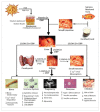Role of Vitamin D in Athletes and Their Performance: Current Concepts and New Trends
- PMID: 32102188
- PMCID: PMC7071499
- DOI: 10.3390/nu12020579
Role of Vitamin D in Athletes and Their Performance: Current Concepts and New Trends
Abstract
We are currently experiencing a vitamin D (VITD) deficiency pandemic across the world. Athletes have the same predisposition to low levels of vitamin D, the majority of its concentrations being below 20 ng/mL in a wide range of sports, especially in the winter months. Vitamin D is important in bone health, but recent research also points out its essential role in extraskeletal functions, including skeletal muscle growth, immune and cardiopulmonary functions and inflammatory modulation, which influence athletic performance. Vitamin D can also interact with extraskeletal tissues to modulate injury recovery and also influence the risk of infection. The data presented in this paper has triggered investigations in relation to the importance of maintaining adequate levels of vitamin D and to the possible positive influence supplementation has on immune and musculoskeletal functions in athletes, benefiting their performance and preventing future injuries. The objective of this review is to describe the latest research conducted on the epidemiology of vitamin D deficiency and its effects on sports performance and musculoskeletal health.
Keywords: 25(OH)D; athlete; athletic performance; deficiency; supplementation; vitamin D.
Conflict of interest statement
The authors declare no conflict of interest.
Figures


References
Publication types
MeSH terms
Substances
LinkOut - more resources
Full Text Sources
Other Literature Sources
Medical

